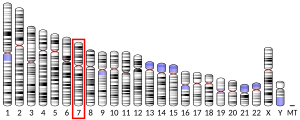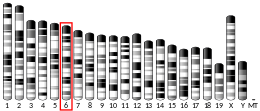TMEM106B
| TMEM106B | |||||||||||||||||||||||||||||||||||||||||||||||||||
|---|---|---|---|---|---|---|---|---|---|---|---|---|---|---|---|---|---|---|---|---|---|---|---|---|---|---|---|---|---|---|---|---|---|---|---|---|---|---|---|---|---|---|---|---|---|---|---|---|---|---|---|
| Identifiers | |||||||||||||||||||||||||||||||||||||||||||||||||||
| Aliases | TMEM106B, transmembrane protein 106B, HLD16 | ||||||||||||||||||||||||||||||||||||||||||||||||||
| External IDs | OMIM: 613413; MGI: 1919150; HomoloGene: 56806; GeneCards: TMEM106B; OMA:TMEM106B - orthologs | ||||||||||||||||||||||||||||||||||||||||||||||||||
| |||||||||||||||||||||||||||||||||||||||||||||||||||
| |||||||||||||||||||||||||||||||||||||||||||||||||||
| |||||||||||||||||||||||||||||||||||||||||||||||||||
| |||||||||||||||||||||||||||||||||||||||||||||||||||
| |||||||||||||||||||||||||||||||||||||||||||||||||||
| Wikidata | |||||||||||||||||||||||||||||||||||||||||||||||||||
| |||||||||||||||||||||||||||||||||||||||||||||||||||
Transmembrane protein 106B is a protein that in humans is encoded by the TMEM106B gene.[5]
Functions
TMEM106B is involved in:[6][7]
- Dendrite morphogenesis and maintenance by regulating lysosomal trafficking via its interaction with MAP6.
- Dendrite branching.
Clinical implications
Frontotemporal dementia is the third most common neurodegenerative disease after AD and Parkinson disease. A study performed in 515 FTLD-TDP cases, including 89 individuals carrying pathogenic mutations in the granulin (GRN) gene, a known cause of familial FTLD-TDP, identified rs1990622, located 6.9 kilobases downstream of the TMEM106B gene (chromosome 7p21) as a genome-wide signal.[8] Interestingly, this signal was stronger among the GRN mutation carriers than in the other FTLD-TDP samples.
Based on these findings, Cruchaga et al.,,[9] analyzed if TMEM106B variants modify GRN levels. The found that The risk allele of rs1990622 was associated with a mean decrease of the age at onset of 13 years (P = 9.9 × 10−7) and with lower plasma GRN levels in both healthy older adults (P = 4 × 10−4) and GRN mutation carriers (P = 0.0027). Analysis of the HapMap database identified a nonsynonymous single-nucleotide polymorphism rs3173615 (p.T185S) in perfect linkage disequilibrium with rs1990622, that my represent the functional variant driving the association. In summary, these results indicate that the association of rs1990622 with age at onset explains, in part, the wide range in the onset of disease among GRN mutation carriers. The rs1990622 or another variant in linkage disequilibrium could act in a manner similar to APOE in Alzheimer disease, increasing risk for disease in the general population and modifying AAO in mutation carriers. Genetic variation in TMEM106B may influence risk for FTLD-TDP by modulating secreted levels of GRN.
A recent genome-wide association study (GWAS) has found that genetic variations in TMEM106 are associated with late-onset sporadic Alzheimer’s disease (LOAD). These genetic variations change the degradation pathways of misfolded protein contributing misfolded β-amyloid accumulation and plaque formation.[10]
In March 2022 its structure was resolved with cryo-EM[11][12] and argued that in the context of FTLD-TDP this is protein involved rather than TDP-43 which was resolved with cryo-EM too in December 2021.[13][14]
Mechanism
Li et al.,[15] developed and validated a digital deconvolution algorithm to determine the cell proportions in a bulk RNA-seq experiment. Then, they leveraged this method to identify genes associated with the neuronal proportions in the human cortex.[16] In this study, Cruchaga (https://neurogenomics.wustl.edu/) and his team demonstrated that the TMEM106B variants associated with lower Frontotemporal dementia risk, are also associated with higher neuronal content. They also demonstrated that this association was independent of disease status, and that TMEM106B is a general protective factor for neurodegeneration, which opens the doors to novel, therapeutic approaches targeting TMEM106B.
Interactions
TMEM106B has been shown to interact with C6orf201.[17]
References
- ^ a b c GRCh38: Ensembl release 89: ENSG00000106460 – Ensembl, May 2017
- ^ a b c GRCm38: Ensembl release 89: ENSMUSG00000029571 – Ensembl, May 2017
- ^ "Human PubMed Reference:". National Center for Biotechnology Information, U.S. National Library of Medicine.
- ^ "Mouse PubMed Reference:". National Center for Biotechnology Information, U.S. National Library of Medicine.
- ^ "Entrez Gene: TMEM106B transmembrane protein 106B".
- ^ Schwenk BM, Lang CM, Hogl S, Tahirovic S, Orozco D, Rentzsch K, et al. (March 2014). "The FTLD risk factor TMEM106B and MAP6 control dendritic trafficking of lysosomes". The EMBO Journal. 33 (5): 450–467. doi:10.1002/embj.201385857. PMC 3989627. PMID 24357581.
- ^ Brady OA, Zheng Y, Murphy K, Huang M, Hu F (February 2013). "The frontotemporal lobar degeneration risk factor, TMEM106B, regulates lysosomal morphology and function". Human Molecular Genetics. 22 (4): 685–695. doi:10.1093/hmg/dds475. PMC 3554197. PMID 23136129.
- ^ Van Deerlin VM, Sleiman PM, Martinez-Lage M, Chen-Plotkin A, Wang LS, Graff-Radford NR, et al. (March 2010). "Common variants at 7p21 are associated with frontotemporal lobar degeneration with TDP-43 inclusions". Nature Genetics. 42 (3): 234–239. doi:10.1038/ng.536. PMC 2828525. PMID 20154673.
- ^ Cruchaga C, Graff C, Chiang HH, Wang J, Hinrichs AL, Spiegel N, et al. (May 2011). "Association of TMEM106B gene polymorphism with age at onset in granulin mutation carriers and plasma granulin protein levels". Archives of Neurology. 68 (5): 581–586. doi:10.1001/archneurol.2010.350. PMC 3090529. PMID 21220649.
- ^ Wightman DP, Jansen IE, Savage JE, Shadrin AA, Bahrami S, Holland D, et al. (September 2021). "A genome-wide association study with 1,126,563 individuals identifies new risk loci for Alzheimer's disease". Nature Genetics. 53 (9): 1276–1282. doi:10.1038/s41588-021-00921-z. PMID 34493870. S2CID 237442349.
- ^ Jiang YX, Cao Q, Sawaya MR, Abskharon R, Ge P, DeTure M, et al. (March 2022). "Amyloid fibrils in disease FTLD-TDP are composed of TMEM106B not TDP-43". Nature. 605 (7909): 304–309. doi:10.1038/s41586-022-04670-9. PMID 35344984. S2CID 247777613.
- ^ "Frontotemporal Dementia: Not the Protein We Thought". www.science.org. Retrieved 2022-04-04.
- ^ Arseni D, Hasegawa M, Murzin AG, Kametani F, Arai M, Yoshida M, Ryskeldi-Falcon B (January 2022). "Structure of pathological TDP-43 filaments from ALS with FTLD". Nature. 601 (7891): 139–143. Bibcode:2022Natur.601..139A. doi:10.1038/s41586-021-04199-3. PMC 7612255. PMID 34880495.
- ^ "An ALS Protein, Revealed". www.science.org. Retrieved 2022-04-04.
- ^ Li Z, Del-Aguila JL, Dube U, Budde J, Martinez R, Black K, et al. (June 2018). "Genetic variants associated with Alzheimer's disease confer different cerebral cortex cell-type population structure". Genome Medicine. 10 (1): 43. doi:10.1186/s13073-018-0551-4. PMC 5992755. PMID 29880032.
- ^ Li Z, Farias FH, Dube U, Del-Aguila JL, Mihindukulasuriya KA, Fernandez MV, et al. (January 2020). "The TMEM106B FTLD-protective variant, rs1990621, is also associated with increased neuronal proportion". Acta Neuropathologica. 139 (1): 45–61. doi:10.1007/s00401-019-02066-0. PMC 6942643. PMID 31456032.
- ^ Rolland T, Taşan M, Charloteaux B, Pevzner SJ, Zhong Q, Sahni N, et al. (November 2014). "A proteome-scale map of the human interactome network". Cell. 159 (5): 1212–1226. doi:10.1016/j.cell.2014.10.050. PMC 4266588. PMID 25416956.
Further reading
- Maruyama K, Sugano S (January 1994). "Oligo-capping: a simple method to replace the cap structure of eukaryotic mRNAs with oligoribonucleotides". Gene. 138 (1–2): 171–174. doi:10.1016/0378-1119(94)90802-8. PMID 8125298.
- Suzuki Y, Yoshitomo-Nakagawa K, Maruyama K, Suyama A, Sugano S (October 1997). "Construction and characterization of a full length-enriched and a 5'-end-enriched cDNA library". Gene. 200 (1–2): 149–156. doi:10.1016/S0378-1119(97)00411-3. PMID 9373149.
- Olsen JV, Blagoev B, Gnad F, Macek B, Kumar C, Mortensen P, Mann M (November 2006). "Global, in vivo, and site-specific phosphorylation dynamics in signaling networks". Cell. 127 (3): 635–648. doi:10.1016/j.cell.2006.09.026. PMID 17081983. S2CID 7827573.





